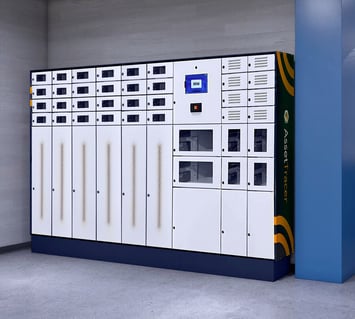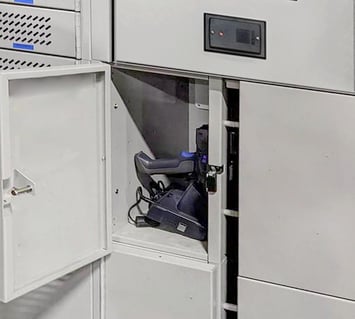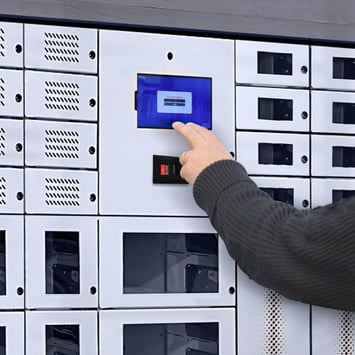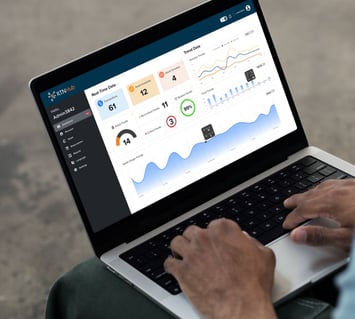By Jay Palter | July 4, 2024
Many businesses still rely on manual equipment tracking processes. Managers may recognize the importance of tracking equipment use and maintenance but believe that using an automated equipment tracking system is too complex or costly.
However, upgrading to an automated equipment tracking system is more straightforward and offers better ROI than equipment managers might think. These systems offer a range of benefits that can make them worthwhile investments for businesses of all sizes and across various industries.
So, what exactly is an equipment tracking system? And how can it enhance equipment management and improve loss prevention strategies? This article aims to answer those questions and more.
What is an equipment tracking system?
A smart locker system is a secure storage and distribution solution integrated with a computer and sensor network. It monitors and manages stored equipment use and the workflows within which your personnel use it. A network of smart technology sensors and computer control systems allows the locker to adjust for better inventory control, such as dynamically managing asset availability based on available devices, flagging items needing maintenance, and alerting administrators to irregular usage patterns.
Unlike traditional lockers, which store items with a simple key or padlock security, smart equipment tracking systems offer much-enhanced functionality. For instance, they could secure and charge a laptop and track who signs it out and when.
Administrators can set user-specific access permissions and receive notifications if the laptop isn’t returned on time. Suppose a user reports a software or hardware issue with the laptop. In that case, the tracking system can prevent anyone else from signing out of that device and automatically create a ticket with the IT support team so they can pull the device for troubleshooting.
Asset surveillance adds a powerful layer of tracking capabilities

Smart lockers track individual assets using a process called asset surveillance. This typically involves passive RFID tags attached to or embedded in assets. The locker system reads these tags to verify that the correct item has been taken or returned.
Additionally, lockers can use USB charging cables to perform asset surveillance. Users plug devices into the included cable when they return them so the tracking system can confirm the device’s identity. Some laptops, tablets, and other smart devices can even self-report issues to the tracking system through this connection.
Learn More:
[Definition] What is Physical Asset Surveillance?
Core components of an equipment tracking system
The lockers
At their core, equipment tracking systems still rely on durable locking cabinets. These cabinets often feature ventilated metal or clear, high-impact polycarbonate doors, which provide security for idle equipment.
Learn More:
What Is A Smart Locker? 10 Reasons Your Business Needs Them

Asset surveillance
Asset surveillance systems track the status of important assets at rest in an equipment tracking locker. The loss prevention technology used for asset surveillance varies by industry and application. Still, the core objective remains consistent: to monitor who accesses an asset, how and when it is used, and its condition before, during, and after use.
These systems are essential for tracking high-value assets or equipment crucial to critical workflows. For many organizations, if essential equipment is not in the right place, not functioning correctly, or unavailable when needed, the consequences can be severe—financially, reputationally, and in terms of employee or public safety.

Smart authentication panel
The authentication panel is crucial for smart business functionality. It controls access by requiring users to authenticate themselves, unlocking only the authorized equipment. Basic authentication can be done using PIN codes, but more secure options include swipe cards, smartphone apps, and biometric scans such as fingerprints, facial recognition, or iris scans.

Management software
Management software consolidates data from the authentication panel and the surveillance system into a user-friendly dashboard. This software allows administrators to customize and review user and transaction reports, aiding in regulatory compliance and providing valuable insights into asset usage and management.

What wireless standards are used for equipment tracking?
A variety of different wireless asset management solutions are in use today. Some of the leading standards for equipment tracking include:
Radio Frequency Identification (RFID)
RFID tracking systems use this flexible wireless technology well-suited for equipment tracking needs. Tags come in unpowered (passive RFID) and powered (active RFID) varieties. Passive tags are suitable for scanning equipment when signed in and out of storage. Active tags have a longer range and can be used for real-time tracking throughout your facility. RFID signals can pass through many materials and do not require line-of-sight to work, but metal surfaces can interfere with them.
Learn More: What is RFID Technology? Choose the Right Technology for Your Business
WiFi Tracking
Equipment tracking systems can also use the same WiFi beacons you use to provide Internet service. These beacons can track equipment location with a connected WiFi card in close to real time.
This service has a longer range than other real-time tracking technologies, but the trade-off is that WiFi tracking tends to be less accurate. You are also limited to locations with good WiFi coverage. Thick walls and other materials can create dead spots.
Bluetooth
Bluetooth is commonly used for pairing mobile devices and computers with wireless accessories, but it can also be used for tracking. Although Bluetooth has a much shorter range than WiFi, it is more accurate and consumes significantly less power. So, in the right environment, it can be a cost-effective solution.
Infrared (IR)
Infrared beams, like those used in TV remotes, can be used for specific equipment tracking needs. IR is a low-cost and low-power technology, but since it uses beams of light, it can only function when there is an unobstructed line of sight between tags and scanners. IR can be a practical choice in controlled environments with lower-risk tracking needs.
What are the benefits of an equipment tracking system?
Integrating an equipment tracking system into your workflow provides several important benefits. Here are twelve key ones.
Equipment tracking software collects data on asset usage, maintenance needs, and usage patterns. Smart lockers automatically log every check-in and check-out event, capturing real-time data on who accessed which equipment and when. This data provides valuable insights for informed decision-making, optimizing maintenance schedules, and equipment allocation.
An equipment tracking system can significantly extend asset lifespans. The system schedules preventative maintenance based on usage data, while smart lockers ensure equipment is always available and in good condition. Automating these processes reduces the risk of unexpected breakdowns and costly repairs, making preventive maintenance more effective.
Learn More:
10 Proven Strategies for Effective Equipment Lifecycle Management
Manual tracking of tools and equipment can be time-consuming and prone to errors. Smart tracking solutions automate the asset check-in/check-out process, streamlining the workflow and reducing administrative burdens. This automation ensures accurate records of asset movements, minimizes human error and frees up time for more critical tasks.
Learn More:
Asset Tracking Technology: Everything You Need to Know
An equipment tracking system efficiently schedules and documents maintenance tasks, while smart lockers ensure the necessary tools and equipment are readily available. This minimizes downtime by ensuring maintenance personnel immediately access the right assets when needed. The tracking system can also alert staff to upcoming maintenance tasks, reducing delays and improving overall productivity.
Smart lockers enhance security by restricting access to authorized personnel and providing detailed usage logs. Each access event is recorded, creating a robust audit trail.
This ensures that only qualified individuals can access sensitive equipment, reducing the risk of misuse or theft. Detailed logs support accountability by tracking who used an asset, for how long, and for what purpose, deterring potential security breaches.
Learn More: Protect Your Bottom Line with Employee Accountability Tracking
Automating administrative tasks like transaction tracking, maintenance scheduling, and reporting frees your staff to focus on more productive activities. This automation reduces the manual workload and allows your team to dedicate more time to revenue-generating tasks.
Equipment tracking systems can automatically generate compliance reports for organizations that need to track regulated assets. Whether tracking the use of controlled substances or electronic devices holding sensitive data, these systems ensure adherence to regulations with minimal manual effort.
Learn More: Ensuring Compliance with Real Time Networks
By automating asset tracking, smart lockers significantly reduce human error. They ensure that every transaction is accurately recorded, and alerts can be sent if equipment is not returned on time. This proactive approach increases the likelihood of recovering lost items and reduces the overall incidence of lost equipment.
Learn More: The True Cost of Asset Loss in a Digital World
Tracking systems equipped with RFID tags and asset surveillance tracking offer detailed insights into equipment use. This data allows administrators to monitor usage patterns, identify performance trends, and pinpoint issues such as recurring hardware problems or individuals responsible for frequent losses, enhancing operational efficiency and asset management.
Equipment tracking systems can use wired USB connections to monitor and charge electronic devices, providing real-time health and maintenance status updates. This integration ensures that any reported issues are promptly addressed, with the lockers securely holding the device until a technician can retrieve it.
In emergencies, administrators can issue an override to unlock all equipment stored in a tracking system to ensure urgent access to necessary equipment like toolkits or medkits. This bypasses the regular access request and checklist procedures designed for day-to-day operations.
Integrating equipment tracking systems with existing administrative, IT and other security systems enhances overall efficiency. For instance, integrating with an electronic access control system or using Active Directory for user management reduces the need for duplicate accounts and streamlines operations.
Equipment tracking systems protect your valuable assets and simplify work
A reliable equipment tracking system offers enhanced visibility into the movement of your most valuable assets, enabling you to respond quickly to issues. By automating routine management tasks, you save time and streamline your company's operations while gaining valuable business intelligence.
[Download]
Ultimate Guide to Smart Lockers
Subscribe to our blog

Jay Palter
Vice President of Marketing & Partnerships




